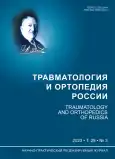Coracoid Process Fracture Associated With a Distal Clavicle Fracture: A Case Report
- Authors: Avdeev A.I.1,2, Parfeev D.G.1, Parshin D.D.2, Sinitsyna E.V.2
-
Affiliations:
- Vreden National Medical Research Center of Traumatology and Orthopedics
- Saint Petersburg State Pediatric Medical University
- Issue: Vol 29, No 3 (2023)
- Pages: 118-123
- Section: Case Reports
- URL: https://journal-vniispk.ru/2311-2905/article/view/255271
- DOI: https://doi.org/10.17816/2311-2905-14793
- ID: 255271
Cite item
Abstract
Background. Fracture of the distal clavicle fracture associated with a coracoid process fracture is extremely rare in the practice of an orthopedic surgeon. Therefore, there is no common approach to the treatment of patients with this type of bone injuries of the shoulder girdle.
Aim of the study — to demonstrate positive experience of conservative treatment of the coracoid process fracture combined with hook plate fixation for distal clavicle fracture.
Case presentation. We present a rare clinical case of a closed distal clavicle fracture associated with coracoid process fracture. Trauma occurred when the patient fell down the stairs on his abducted upper limb. After examination, the distal clavicle fracture was fixed with a hook plate. Intraoperatively, X-rays showed a satisfactory position of the coracoid process of the scapula. Therefore, it was decided not to fix it additionally. CT scans three months after the surgery showed bone fragments consolidation. Removal of the hook plate and screws from the clavicle was performed.
Conclusion. Presented clinical case illustrates successful treatment result of this type of fractures without fixation of the coracoid process fracture. The hook plating allows to stabilize bone fragments and restore ligament tension, which makes this implant non-alternative for fixation of this type of injuries.
Full Text
##article.viewOnOriginalSite##About the authors
Alexander I. Avdeev
Vreden National Medical Research Center of Traumatology and Orthopedics; Saint Petersburg State Pediatric Medical University
Author for correspondence.
Email: spaceship1961@gmail.com
ORCID iD: 0000-0002-1557-1899
SPIN-code: 2799-2563
Cand. Sci. (Med.), head of reception department, assistant University
Russian Federation, 8, Akademika Baykova st., St. Petersburg, 195427; 2, Litovskaya str., St. Petersburg, 194100Dmitrii G. Parfeev
Vreden National Medical Research Center of Traumatology and Orthopedics
Email: dgparfeev@rniito.ru
ORCID iD: 0000-0001-8199-7161
Cand. Sci. (Med.), head of trauma and orthopedic Department N 1
Russian Federation, 8, Akademika Baykova st. Saint Petersburg, 195427Danil D. Parshin
Saint Petersburg State Pediatric Medical University
Email: parshindanil1997@gmail.com
ORCID iD: 0009-0002-0010-1437
Clinical resident
Russian Federation, 2, Litovskaya str., St. Petersburg, 194100Ekaterina V. Sinitsyna
Saint Petersburg State Pediatric Medical University
Email: katerin_tomtit@mail.ru
ORCID iD: 0009-0002-9798-7886
Clinical resident
Russian Federation, 2, Litovskaya str., St. Petersburg, 194100References
- Nordqvist A., Petersson C. The incidence of fractures of the clavicle. Clin Orthop Relat Res. 1994;300:127-132.
- Postacchini F., Gumina S., De Santis P., Albo F. Epidemiology of clavicle fractures. J Shoulder Elbow Surg. 2002;11(5):452-456. doi: 10.1067/mse.2002.126613.
- Robinson C.M. Fractures of the clavicle in the adult. Epidemiology and classification. J Bone Joint Surg Br. 1998;80(3):476-484. doi: 10.1302/0301-620x.80b3.8079.
- Knapik D.M., Patel S.H., Wetzel R.J., Voos J.E. Prevalence and Management of Coracoid Fracture Sustained During Sporting Activities and Time to Return to Sport: A Systematic Review. Am J Sports Med. 2018;46(3): 753-758. doi: 10.1177/0363546517718513.
- Jettoo P., de Kiewiet G., England S. Base of coracoid process fracture with acromioclavicular dislocation in a child. J Orthop Surg Res. 2010;5:77. doi: 10.1186/1749-799X-5-77.
- Pedersen V., Prall W.C., Ockert B., Haasters F. Non-operative treatment of a fracture to the coracoid process with acromioclavicular dislocation in an adolescent. Orthop Rev (Pavia). 2014;6(3):5499. doi: 10.4081/or.2014.5499.
- Li J., Sun W., Li G.D., Li Q., Cai Z.D. Fracture of the coracoid process associated with acromioclavicular dislocation: a case report. Orthop Surg. 2010;2(2): 165-167. doi: 10.1111/j.1757-7861.2010.00080.x.
- Kim K.C., Rhee K.J., Shin H.D., Kim D.K., Shin H.S. Displaced fracture of the coracoid process associated with acromioclavicular dislocation: a two-bird-one-stone solution. J Trauma. 2009;67(2):403-405. doi: 10.1097/TA.0b013e3181ac8ef1.
- Asbury S., Tennent T.D. Avulsion fracture of the coracoid process: a case report. Injury. 2005;36(4): 567-568. doi: 10.1016/j.injury.2004.11.002.
- Lee J.H., Kim J.R., Wang S.I. An unusual mechanism of coracoid fracture in a beginner golfer. Knee Surg Sports Traumatol Arthrosc. 2018;26(1):76-78. doi: 10.1007/s00167-017-4439-4.
- Wollstein J., Tegtbur U., Meller R., Hanke A.A., Berndt T., Krettek C. et al. Isolated fracture of the coracoid process in a 14-year-old national water polo player: Case example. Unfallchirurg. 2019;122(1):79-82. (In German). doi: 10.1007/s00113-018-0547-y.
- Iqbal A., Botchu R. Coracoid stress injury: a report of an unusual case and review of literature. REJR. 2020;10(3):174-178. doi: 10.21569/2222-7415-2020-10-3-174-178.
- Zhang W., Huang B., Yang J., Xue P., Liu X. Fractured coracoid process with acromioclavicular joint dislocation: A case report. Medicine (Baltimore). 2020; 99(39):e22324. doi: 10.1097/MD.0000000000022324.
- Broekman M.M., Verstift D.E., Doornberg J.N., van den Bekerom M.P.J. Treatment of acromioclavicular dislocations with a concomitant coracoid fracture: a systematic review of 37 patients. JSES Int. 2022;7(2):225-229. doi: 10.1016/j.jseint.2022.12.014.
Supplementary files












